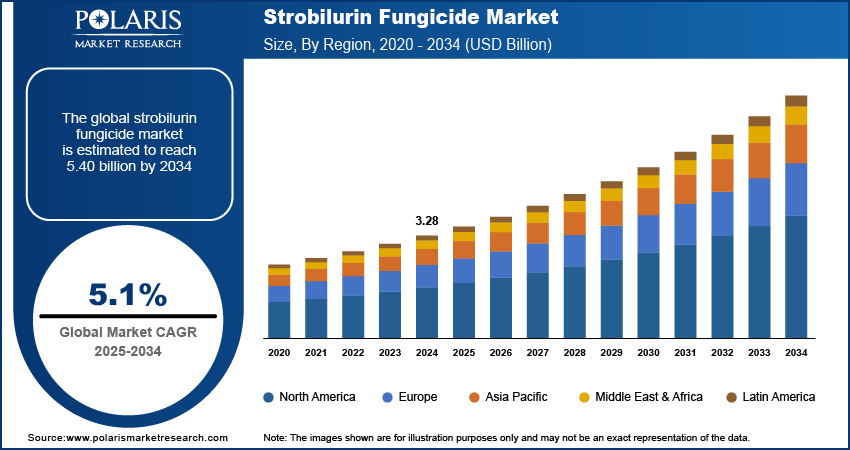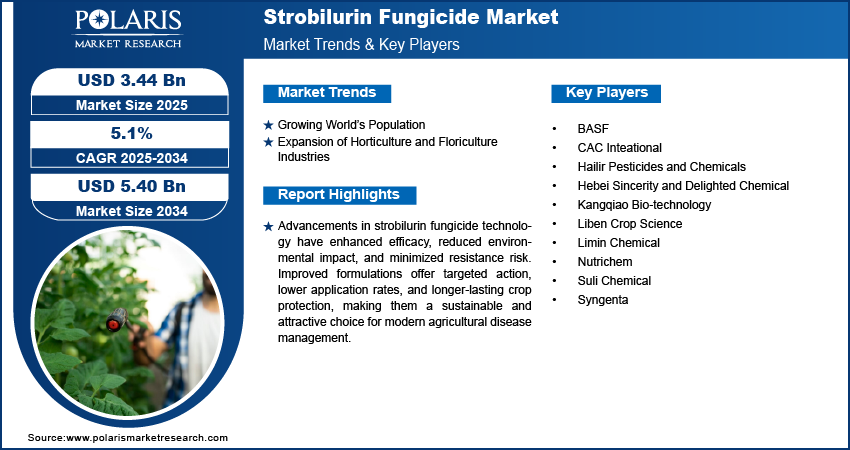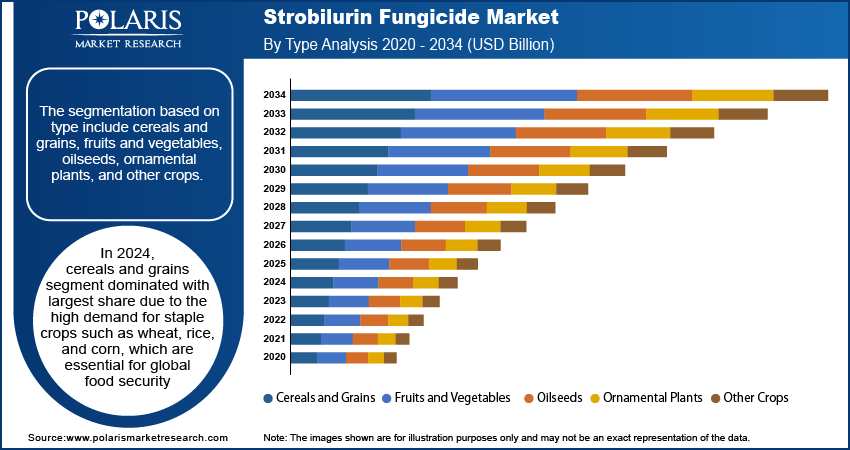
Strobilurin Fungicide Market Size, Share, & Trends, Analysis Report
By Type (Cereals and Grains, Fruits and Vegetables, Oilseeds, Ornamental Plants, Other Crops), By Formulation, By Application, By End User, and By Region – Market Forecast, 2025–2034
- Published Date:Jun-2025
- Pages: 129
- Format: PDF
- Report ID: PM5848
- Base Year: 2024
- Historical Data: 2020-2023
The global Strobilurin Fungicide Market size was valued at USD 3.28 billion in 2024, growing at a CAGR of 5.1% from 2025 to 2034. Key factor driving the demand include growing world’s population, and expansion of horticulture and floriculture industries.
Market Overview
Strobilurin fungicides are a class of agricultural chemicals derived from natural antifungal compounds produced by certain fungi, used to protect crops by inhibiting mitochondrial respiration in pathogenic fungi. They are known for their broad-spectrum activity and are commonly applied to control diseases in cereals, fruits, and vegetables.
Climate change is impacting weather patterns, leading to increased humidity and temperature fluctuations that favor the proliferation of fungal diseases in crops. This heightened disease pressure poses a significant threat to agricultural productivity. Strobilurin fungicides offer a reliable solution to manage these challenges by effectively controlling a broad spectrum of fungal pathogens. Their mode of action disrupts the energy production in fungi, preventing disease spread and ensuring crop health. The demand for strobilurin fungicides grows as farmers face the impacts of climate change, as they provide a crucial tool for adapting to changing environmental conditions and maintaining crop yields, thereby driving the growth.

The field of fungicide technology has seen significant advancements, leading to the development of more efficient and environmentally friendly strobilurin formulations. These innovations focus on improving the efficacy of fungicides while minimizing their environmental impact. Modern strobilurin fungicides are designed to be more targeted, requiring lower application rates and reducing the risk of resistance development in pathogens. Additionally, advancements in formulation technology improve the stability and persistence of these fungicides, ensuring longer-lasting protection for crops. These technological improvements make strobilurin fungicides more appealing to farmers looking for sustainable and effective disease management solutions, thereby driving their adoption.
Industry Dynamics
Growing World’s Population
The global population is growing which is fueling the demand for food production. According to the United Nations, the world population is expected to reach 9.8 billion by 2050. This surge fuels improved agricultural production, driving the demand for effective crop protection solutions such as strobilurin fungicides. These fungicides play a major role in maximizing crop yields by protecting against a wide range of fungal diseases. Strobilurin fungicides help meet the growing consumption needs by ensuring healthier crops and reducing losses. Their ability to improve food security makes them indispensable in modern smart agriculture, thereby driving the industry growth.
Expansion of Horticulture and Floriculture Industries
The horticulture and floriculture industries are experiencing globally, driven by urbanization, rising incomes, and changing consumer preferences. According to the US Department of Agriculture, in US alone agriculture and related industries employs 10.4% of total country’s employment. These sectors require high-quality plants and flowers, free from diseases that compromise their aesthetic and commercial value. Strobilurin fungicides are essential in these industries for their ability to effectively manage fungal diseases which ensure the production of healthy and visually appealing plants. The demand for garden planter increases as more people engage in gardening and landscaping, further boosting the demand for reliable fungicide solutions, thereby driving the growth.

Segmental Insights
Type Analysis
The segmentation based on type include cereals and grains, fruits and vegetables, oilseeds, ornamental plants, and other crops. In 2024, cereals and grains segment dominated with largest share due to the high demand for staple crops such as wheat, rice, and corn, which are essential for global food security. Strobilurin fungicides are particularly effective in protecting these crops from a variety of fungal diseases, ensuring healthy growth and optimal yields. Farmers prioritize these fungicides to safeguard their cereal and grain production, as any loss can significantly impact food supply chains. The effectiveness of strobilurin fungicides in improving crop resilience and productivity makes them a preferred choice for cereals and grains, thereby driving the segment growth.
Formulation Analysis
The segmentation based on formulation includes granules, liquid concentrates, suspension concentrates, water-soluble powders, emulsifiable concentrates. The granules segment is expected to record significant growth as these formulations offer several advantages, including ease of application and reduced drift during application, which improves their effectiveness. Granules are applied directly to the soil, providing targeted protection to the plant roots and minimizing environmental impact. This form is particularly beneficial for crops that require precise application methods. The demand for granular strobilurin fungicides is increasing as farmers seek more efficient and sustainable solutions, driven by their convenience and ability to deliver consistent results in various agricultural settings, thereby driving the segment growth.
Application Analysis
The segmentation based on application include foliar application, soil application, seed treatment, post-harvest, aerial spraying. In 2024, foliar application segment dominated with largest share as this method involves applying fungicides directly to the leaves, where they quickly combat fungal infections. Foliar application is favored for its rapid action and ability to cover large areas efficiently, making it ideal for managing diseases in crops like fruits, vegetables, and cereals. The direct contact with the plant surface ensures effective disease control, improving crop health and yield, thereby driving the segment growth.
The seed treatment is expected to experience significant growth during the forecast period as this method involves treating seeds before planting, providing early protection against soil-borne and seed-borne fungal diseases. Seed treatment ensures that crops have a healthy start, improving germination rates and seedling vigor. More farmers are adopting seed treatment to improve crop resilience and yield potential as awareness of the benefits of early disease management grows. The increasing focus on sustainable agriculture and reducing chemical use further supports the growth of seed treatment applications, thereby driving the segment growth.

Regional Analysis
Strobilurin Fungicide Market in North America
North America strobilurin fungicide market dominated with largest share in 2024, driven by advanced agricultural practices and a strong focus on crop protection. Farmers in this region prioritize high-yield crops such as corn and soybeans, which require effective disease management. The adoption of innovative farming technologies and integrated pest management strategies further boosts the demand for strobilurin fungicides. Additionally, regulatory support and awareness programs about sustainable farming practices contribute to growth. The demand for strobilurin fungicides is growing as North American farmers continue to seek efficient solutions to enhance productivity and combat climate-related challenges, thereby driving the growth.
Strobilurin Fungicide Market in US
US strobilurin fungicide market is expected to witness significant growth driven by large agricultural activities and a diverse range of crops. The country’s large-scale farming operations and emphasis on maximizing yields drive the demand for effective fungicide solutions. Strobilurin fungicides are widely used to protect major crops like corn, wheat, and soybeans from fungal diseases. The presence of leading agricultural companies and ongoing research and development efforts support market expansion. The adoption of strobilurin fungicides continues to grow as US farmers face increasing disease pressures and strive for sustainable practices, thereby driving the growth.
Strobilurin Fungicide Market in Aisa Pacific
Asia Pacific Strobilurin Fungicide Market is projected witness substantial growth due to its vast agricultural landscape and rising food demand. Countries in this region are focusing on improving agricultural productivity to meet the needs of their growing populations. Strobilurin fungicides are essential in managing diseases in major crops such as rice, wheat, and fruits. Additionally, the increasing adoption of modern farming techniques and government initiatives to support agricultural development further drive the growth. The demand for these fungicides in Asia Pacific is expected to rise steadily as awareness of crop protection benefits spreads among farmers, thereby driving the growth in Asia Pacific.
Strobilurin Fungicide Market in China
US Strobilurin Fungicide Market is expected to experience significant growth driven by the country’s large agricultural sector and the need to ensure food security. Chinese farmers are increasingly adopting strobilurin fungicides to protect staple crops such as rice and wheat from fungal diseases. Government policies promoting sustainable agriculture and investments in agricultural research fuels the growth. Additionally, the shift towards high-value crops and the adoption of advanced farming practices contribute to the rising demand for effective fungicide solutions. Moreover, the use of strobilurin fungicides is expected to grow as China continues to modernize its agricultural sector, thereby driving the growth.
Strobilurin Fungicide Market in Europe
Europe Strobilurin Fungicide Market is expected to experience significant growth driven by the region's diverse agricultural activities and stringent regulations on crop protection. European farmers focus on sustainable practices and integrated pest management, due to which the use of strobilurin fungicides is rising. These fungicides are important for protecting a variety of crops, including cereals, fruits, and vegetables, from fungal diseases. The emphasis on high-quality produce and environmental safety further fuels the adoption of advanced fungicide solutions. The demand for strobilurin fungicides is rising as Europe continues to prioritize sustainable agriculture and food security, thereby driving the growth.
Strobilurin Fungicide Market in Germany
Germany Strobilurin Fungicide Market is expected to experience significant growth as the country is known for its preference toward high-quality, dermatologist-recommended skincare products. The country has a large base of health-conscious and environmentally aware consumers who value products that are both effective and sustainable. German skincare brands focus on minimal, clean formulations, making emollients such as esters and fatty acids highly desirable. The pharmaceutical and cosmeceutical segments are also strong in Germany, further boosting demand for therapeutic skincare items. Moreover, growing interest in natural beauty and a tradition of herbal care products is driving the growth in Germany.

Key Players & Competitive Analysis
The strobilurin fungicide market is highly competitive, with major global and regional players driving innovation and market share. BASF and Syngenta lead with established strobilurin products like pyraclostrobin and azoxystrobin, benefiting from extensive R&D and distribution networks. Chinese firms such as CAC International, Hailir, Hebei Sincerity, Delighted Chemical, Kangqiao Bio-technology, Liben Crop Science, Limin Chemical, Nutrichem, and Suli Chemical are rapidly expanding their portfolios through generic versions and cost-effective manufacturing. These companies leverage China's production advantages to meet global demand and challenge multinational dominance. Recent innovations, such as Sumitomo’s Bifemetstrobin and Syngenta’s Metcyclofenstrobin, indicate ongoing product development aimed at overcoming resistance and enhancing efficacy. The market is influenced by patent expiries, regulatory shifts, and rising demand for sustainable crop protection. Collaboration, formulation technology, and strategic registrations are key differentiators in this dynamic sector. Overall, players focus on innovation, cost-efficiency, and global reach to maintain a competitive edge.
Key Players
- BASF
- CAC Inteational
- Hailir Pesticides and Chemicals
- Hebei Sincerity and Delighted Chemical
- Kangqiao Bio-technology
- Liben Crop Science
- Limin Chemical
- Nutrichem
- Suli Chemical
- Syngenta
Industry Developments
In June 2024, Sumitomo Chemical launched its new strobilurin fungicide, Bifemetstrobin (S-2326) after receiving provisional ISO approval. The compound demonstrated strong efficacy against various plant diseases and was protected by newly filed international patents.
Strobilurin Fungicide Market Segmentation
By Type Outlook (Revenue, USD Billion, 2020–2034)
- Cereals and Grains
- Fruits and Vegetables
- Oilseeds
- Ornamental Plants
- Other Crops
By Formulation Outlook (Revenue, USD Billion, 2020–2034)
- Granules
- Liquid Concentrates
- Suspension Concentrates
- Water-soluble Powders
- Emulsifiable Concentrates
By Application Outlook (Revenue, USD Billion, 2020–2034)
- Foliar Application
- Soil Application
- Seed Treatment
- Post-Harvest
- Aerial Spraying
By End User Outlook (Revenue, USD Billion, 2020–2034)
- Agricultural Farms
- Commercial Growers
- Research Institutions
- Home Gardeners
- Distribution and Retailers
By Regional Outlook (Revenue, USD Billion, 2020–2034)
- North America
- US
- Canada
- Mexico
- Europe
- Germany
- France
- UK
- Italy
- Spain
- Netherlands
- Russia
- Rest of Europe
- Asia Pacific
- China
- Japan
- India
- Malaysia
- South Korea
- Indonesia
- Australia
- Vietnam
- Rest of Asia Pacific
- Middle East & Africa
- Saudi Arabia
- UAE
- Israel
- South Africa
- Rest of Middle East & Africa
- Latin America
- Brazil
- Argentina
- Rest of Latin America
Strobilurin Fungicide Market Report Scope
|
Report Attributes |
Details |
|
Market Size Value in 2024 |
USD 3.28 Billion |
|
Market Size Value in 2025 |
USD 3.44 Billion |
|
Revenue Forecast by 2034 |
USD 5.40 Billion |
|
CAGR |
5.1% from 2025 to 2034 |
|
Base Year |
2024 |
|
Historical Data |
2020–2023 |
|
Forecast Period |
2025–2034 |
|
Quantitative Units |
Revenue in USD Billion and CAGR from 2025 to 2034 |
|
Report Coverage |
Revenue Forecast, Competitive Landscape, Growth Factors, and Industry Trends |
|
Segments Covered |
|
|
|
|
Competitive Landscape |
|
|
Report Format |
|
|
Customization |
Report customization as per your requirements with respect to countries, regions, and segmentation. |
FAQ's
The global market size was valued at USD 3.28 billion in 2024 and is projected to grow to USD 5.40 billion by 2034.
The global market is projected to register a CAGR of 5.1% during the forecast period.
Asia Pacific dominated the market share in 2024.
A few of the key players in the market are BASF, CAC International, Hailir Pesticides and Chemicals, Hebei Sincerity and Delighted Chemical, Kangqiao Bio-technology, Liben Crop Science, Limin Chemical, Nutrichem, Suli Chemical, Syngenta.
The cereals and grains segment dominated the market share in 2024.
The granules segment is expected to witness the significant growth during the forecast period.
